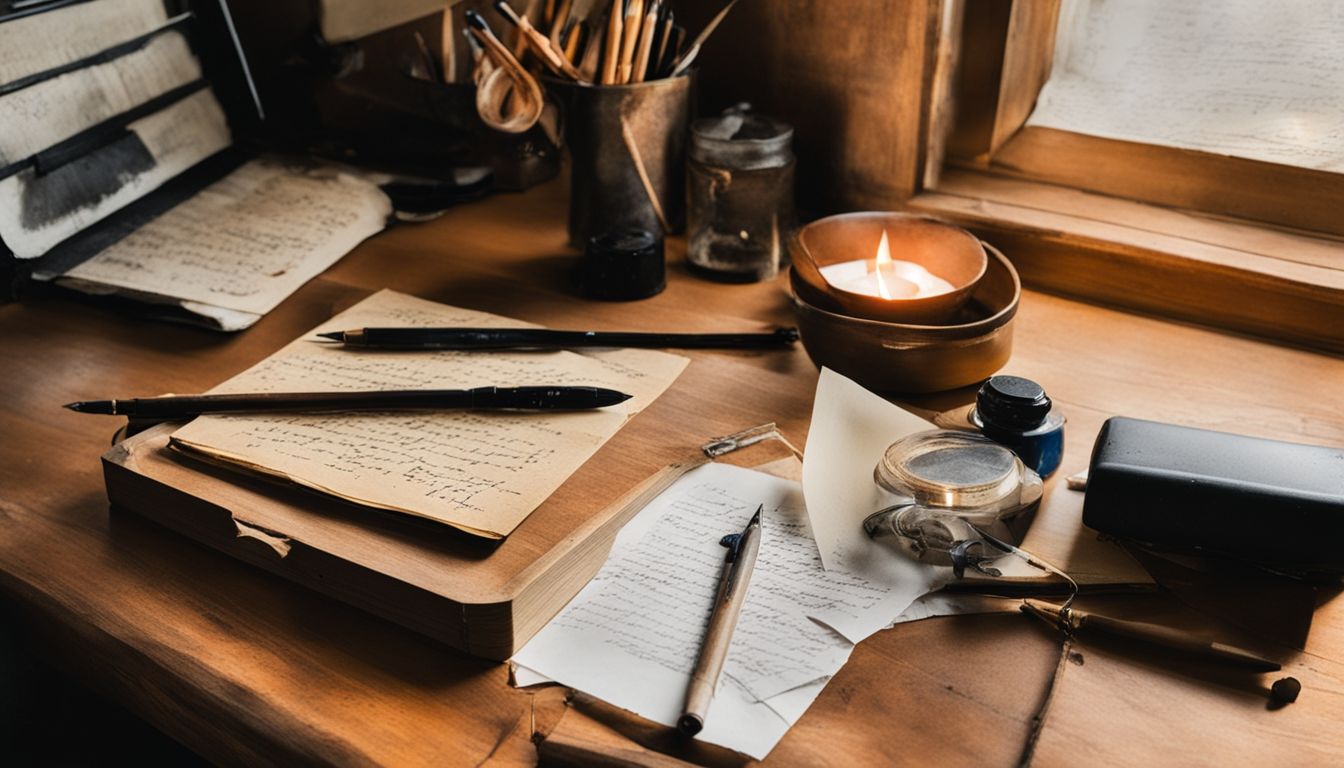Having difficulty refining your handwriting? Essential calligraphy strokes are the cornerstone. This guide will present the eight fundamental strokes to reinvent your writing. Join us to explore a sphere of beautiful letters!
Essential Tools for Practicing Calligraphy

When practicing calligraphy, essential tools include specialized pens, quality paper, a ruler, and a pencil. These tools are fundamental for refining your calligraphy skills and ensuring precision in your strokes.
Pens
Choosing the right pens is crucial for mastering basic strokes in modern calligraphy. Small brush pens, like the Tombow Fudenosuke or Pentel Touch Brush Pen, are perfect for beginners.
They allow you to control thick and thin lines easily, which is essential for creating beautiful lettering. For those just starting out or practicing on a budget, a simple 2B pencil or ballpoint pens can also serve well.
These alternatives offer a forgiving way to practice pressure without investing in specialized equipment.
For hobbyists looking to dive deeper into the art of calligraphy, investing in calligraphy-specific pens becomes vital. These writing instruments help refine your penmanship and bring elegance to each character, from minuscules to ascenders and descenders in lowercase alphabet scripts.
From my experience, using these suggested tools elevates the quality of work whether it’s for personal projects or showcasing on social media. The transition from practice sheets to final pieces feels seamless with the proper pen in hand.
Paper
After selecting the right pens, choosing the best paper is essential for calligraphy practice. HP Premium 32, Canson Marker Paper, and Rhodia Paper are top choices among calligraphers.
These papers stand out because they prevent ink from bleeding through. This means your brush lettering or hand lettering will look clean and crisp, with each stroke defined perfectly.
Bleed-proof marker paper works exceptionally well for practices involving compound curves, descending loops, ascending loops, reverse ovals, and other basic strokes in cursive writing.
It lets you make smooth transitions without worrying about the ink spreading into unwanted areas. Using high-quality paper like HP Premium 32 ensures that every detail of your calligraphy shines through.
Ruler
After choosing the right calligraphy paper, a ruler becomes essential for keeping your writing straight and uniform. A rolling ruler is especially useful for creating guidelines on your paper.
This tool helps ensure that each letter sits neatly on an invisible baseline, making your calligraphy look professional and polished.
Using a ruler also aids in measuring the x-height of letters consistently. The x-height is the height of lowercase letters like ‘x’, which do not have ascenders or descenders. Keeping this measurement consistent is key to maintaining uniformity in your work.
With practice, using a rolling ruler will become second nature, allowing you to focus more on mastering each stroke’s pressure and angle for beautiful calligraphy results.
Pencil
For calligraphy practice, a mechanical pencil is recommended, ideally an HB. Alternatively, a 2B pencil can be used to achieve similar results. These pencils offer the precision and control necessary for mastering basic calligraphy strokes.
Overview of the 8 Basic Calligraphy Strokes
Learn the fundamental calligraphy strokes that form the basis of beautiful lettering. Delve into mastering these essential techniques to enhance your calligraphy skills and create stunning artwork.
Entry Stroke
The entry stroke is a thin, curved line that begins and ends many letters, such as ‘b’, ‘a’, and ‘c’. It’s important to execute this stroke with finesse to achieve the proper foundation for calligraphy letters.
This initial flourish sets the tone for your entire piece and allows you to lead into the subsequent strokes seamlessly.
To master the entry stroke, ensure that you employ consistent pressure and maintain a steady angle throughout. Using high-quality pens from reputable retailers like Amazon.com can enhance the precision of your strokes.
With practice, you’ll be able to expertly craft these delicate lines for an elegant finish on your calligraphy pieces.
Moving onto Essential Tools for Practicing Calligraphy…
Underturn
The downswing stroke is commonly employed in lowercase letters such as ‘a’ and ‘i’. It commences with a substantial downward stroke, curves at the base, and concludes with a gentle upward stroke.
This technique can be honed using quills or contemporary pens, ensuring uniform pressure to attain the intended impact.
To excel in the downswing stroke, utilize suitable implements like specialized calligraphy pens that provide command over line width. Moreover, practicing on high-quality paper with appropriate texture and weight will elevate your proficiency in executing this stroke.
Keep in mind to maintain a comfortable hold on the pen for optimal results when executing intricate strokes.
Overturn
The upward stroke commences with a gentle upward movement, arches at the peak, and then widens downward. This stroke is vital in fashioning various calligraphy letters and contributes grace to your writing.
When practicing the upward stroke, be sure to maintain even pressure and angle for a seamless shift from slender to bold lines.
As you refine this stroke, keep in mind that it’s crucial to regularly practice using practice sheets to refine your skills. Persistent practice will assist you in attaining expertise in the upward stroke and enhancing your calligraphy writing.
After mastering the upward strokes, we’ll move on to guidance on the Compound Curve within Basic Calligraphy Strokes.
Compound Curve
Transitioning from the – Overturn, the next fundamental stroke is the Compound Curve. This pivotal stroke combines an overturn and an underturn, effectively linking two strokes together to form a seamless curve.
Aspiring calligraphers will encounter this essential component at the end of letters such as “n”. Mastering the Compound Curve is crucial for achieving fluid and balanced letterforms in calligraphy.
Practitioners should focus on diligently practicing this stroke, understanding its structure, and incorporating it within their letter formations to enhance their calligraphy proficiency.
Oval
The oval stroke is crucial in calligraphy, appearing in letters like ‘a’, ‘g’, and partially in ‘c’. To draw an oval, start at the 2 o’clock position and move counterclockwise while maintaining pressure control.
This stroke calls for accuracy and consistent practice to excel.
In mastering the oval stroke, keep in mind it plays a vital role in forming specific letters. The execution involves commencing from a specific point and moving in a defined direction, requiring precise control of pressure to achieve uniformity.
With diligent practice using guided techniques, you can enhance your proficiency with this fundamental calligraphy stroke.
Reverse Oval
The reverse oval starts by moving straight up, then curves clockwise and ends with a thick downward stroke. This stroke is commonly used in the creation of the letter ‘b’ in calligraphy.
When practicing this stroke, it’s crucial to focus on maintaining consistent pressure and control throughout the movement to achieve the desired thickness at the end of the stroke.
When creating a reverse oval, apply even pressure as you move upward before smoothly transitioning into a clockwise curve. Finally, increase pressure as you guide your pen downward for a bold and definitive finish.
Ascending Loop
Transitioning from the reverse oval, we come to the ascending loop – a stroke found in letters like ‘b’ and ‘l’. When executing this stroke, start with a thin curve upwards followed by a thicker downwards curve while maintaining parallelism.
This is an essential part of mastering calligraphy strokes. The ascending loop adds elegance and flair to your lettering, making it stand out.
Understanding the nuanced movements required for each calligraphy stroke is crucial for achieving mastery. Consistent practice using proper tools like high-quality pens, smooth paper, and precise rulers will enhance your skill level over time.
Incorporating the techniques associated with pressure and angle will refine this specific stroke further, ensuring you achieve impeccable results when crafting letters that include the ascending loop.
Descending Loop
Transitioning from the ascending loop, let’s take a look at the descending loop. This stroke begins at the header line, extends down below the baseline, and then loops back up to meet it again.
The descending loop is commonly found in letters like ‘g’ and mastering this stroke is essential for achieving fluidity and consistency in calligraphy writing.
To create a beautiful descending loop, ensure that your pen maintains consistent pressure as it descends below the baseline and then curves back up smoothly. Practice with precision on both paper and specialized practice sheets to hone your skills with this essential calligraphy stroke.
Techniques for Mastering Each Stroke
To master each stroke, practice maintaining consistent pressure and angle. Sequencing the strokes in the right order is crucial to perfecting calligraphy. Keep reading for detailed guidance on honing your techniques.
Tips on Pressure and Angle
Use gentle pressure on the downstrokes to achieve thicker lines, while using lighter pressure on the upstrokes for thinner lines. Utilize a consistent angle of around 45 degrees when positioning your pen or brush for optimal results.
It’s important to practice at this angle with diagonal guideline sheets and concentrate on maintaining it throughout your strokes.
Guidance on Stroke Sequencing
After understanding the importance of pressure and angle, it’s essential to follow a logical order when practicing calligraphy strokes. Mastering letter formation before combining strokes is crucial.
Avoid rushing through all the different strokes at once. This strategy can lead to confusion and frustration instead of progress. Start with fundamental strokes like the entry stroke and underturn, then gradually move on to more complex ones such as compound curves and loops.
Develop consistency in stroke sequencing by dedicating focused practice sessions to each individual stroke. Setting aside time for each stroke allows you to grasp its unique characteristics fully.
John Jenkins’ advice from 1813 still holds true: master one before moving onto another.
Practicing Your Strokes
Practice your calligraphy strokes with dedicated practice sheets and consistent effort. Improve your skills through regular, focused practice. Keep honing your technique to see progress over time.
Using Practice Sheets
Practice sheets are an essential tool for refining calligraphy skills. The practice sheets guide learners through each stroke, offering a consistent framework for honing their technique.
They also help in tracking progress and identifying areas that need improvement. It’s recommended to use the practice sheets daily, aiming for at least 15 minutes of dedicated practice over the course of 30 days.
These resources are available in the Lettering Crate, providing a structured approach to perfecting calligraphy strokes.
There is a recipe for success with calligraphy; utilizing these practice sheets consistently can yield remarkable improvements in your skill set within a month.
Consistent Practice Recommendations
Practicing regularly is key to improving calligraphy skills. Set aside dedicated time for practice each day or week, and aim for consistency rather than perfection. Encourage yourself to actively engage in repetitive practice sessions.
Be motivated by the progress you see over time, which will help keep you engaged with the learning process. Strive for improvement with every stroke, rather than focusing solely on achieving flawless results.
Conclusion
Mastering the 8 basic calligraphy strokes is vital for perfecting your craft. Understanding the tools and techniques opens the path to proficiency. Consistent practice and dedication are crucial in refining your skills.
Using practice sheets and proper guidance can lead to success in creating beautiful calligraphy. Begin your journey mastering basic calligraphy strokes with confidence!
FAQs
Apologies for the confusion, but there don’t seem to be any keywords provided for Article 2. Could you please provide them so I can generate the FAQs?




Leave a Reply
You must be logged in to post a comment.